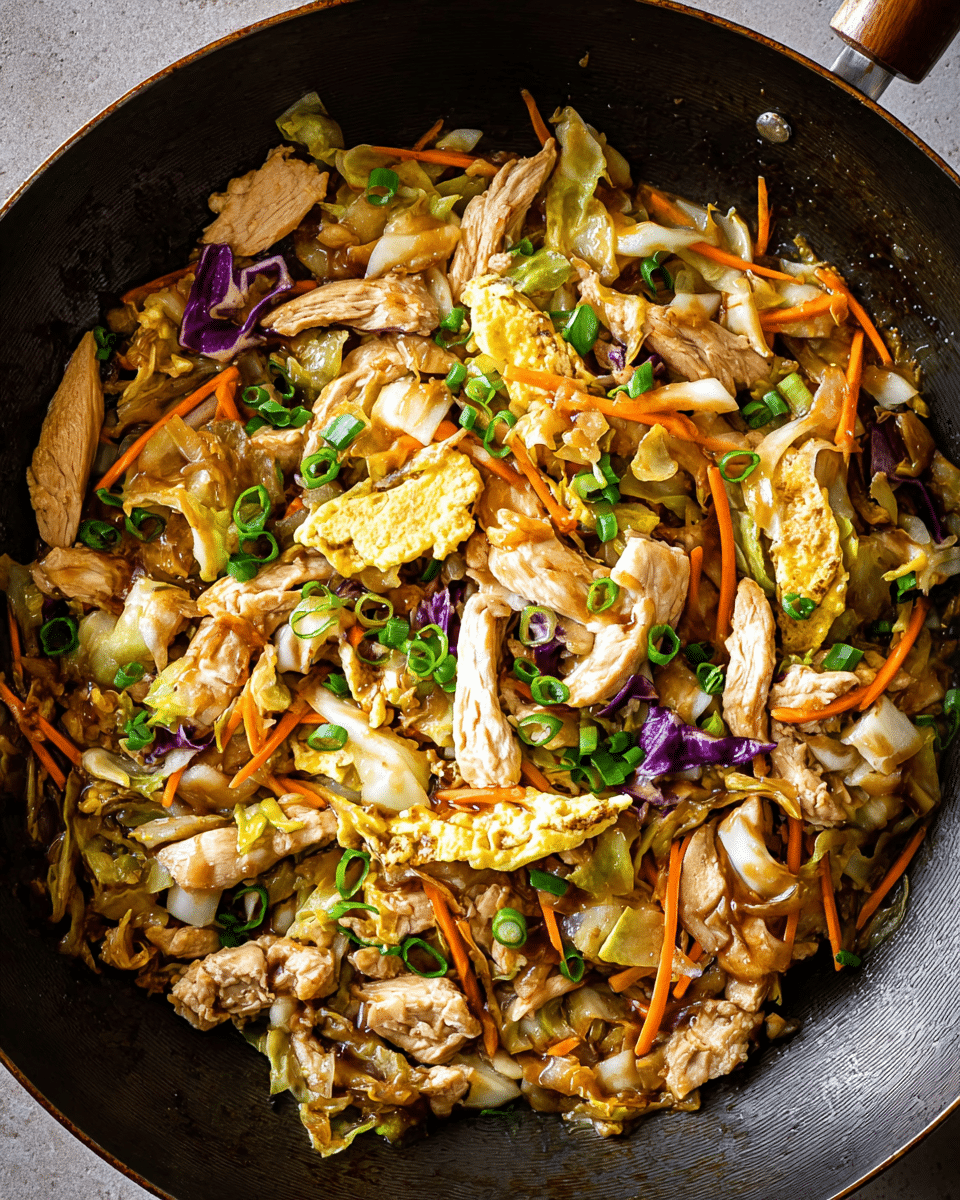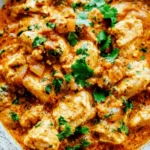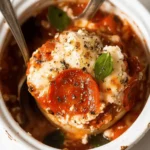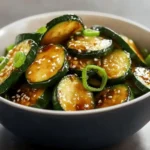The Moo Shu Chicken is a savory stir-fry that blends the vibrant textures of crisp cabbage and carrots with juicy strips of chicken, tossed in a rich and slightly sweet hoisin sauce. It’s a healthy, flavorful take on a popular Chinese-American dish that’s ready in less than 30 minutes. Served in warm tortillas or traditional Mandarin pancakes, this dish makes for a fun, build-your-own meal experience at the table.
Perfect for busy weeknights, this recipe hits all the right notes: quick, tasty, protein-rich, and full of colorful vegetables. It’s also incredibly versatile feel free to substitute chicken with tofu or shrimp, and adjust the veggies to whatever you have on hand. The combination of garlic, ginger, soy, and hoisin sauce creates a bold, umami-packed flavor that even picky eaters will love. Whether you’re new to stir-fry or a seasoned cook, this dish will surely earn a place in your regular dinner rotation.
Full Recipe:
Ingredients:
-
1 lb boneless, skinless chicken breasts, thinly sliced
-
2 tablespoons vegetable oil
-
2 large eggs, lightly beaten
-
3 cups shredded green cabbage
-
1 cup shredded carrots
-
1/2 cup sliced green onions
-
1 tablespoon minced garlic
-
1 tablespoon grated fresh ginger
-
1/4 cup hoisin sauce
-
2 tablespoons low-sodium soy sauce
-
1 tablespoon rice vinegar
-
8 small flour tortillas or Mandarin pancakes
-
Salt and pepper to taste
Directions:
-
Heat 1 tablespoon oil in a large skillet or wok over medium-high heat. Add the chicken slices, season lightly with salt and pepper, and stir-fry for 4-5 minutes until cooked through. Remove from skillet and set aside.
-
Add remaining oil to the skillet. Pour in the beaten eggs and scramble until just cooked. Remove and set aside with the chicken.
-
In the same skillet, add garlic and ginger. Stir-fry for 30 seconds until fragrant.
-
Add the cabbage, carrots, and green onions. Stir-fry for 3-4 minutes until slightly wilted but still crisp.
-
Return the cooked chicken and eggs to the pan. Stir in hoisin sauce, soy sauce, and rice vinegar. Cook for another 2-3 minutes until everything is well coated and heated through.
-
Warm the tortillas or pancakes in a separate pan or microwave.
-
Spoon the Moo Shu mixture into the center of each tortilla. Roll up and enjoy immediately.
Prep Time: 10 minutes | Cooking Time: 15 minutes | Total Time: 25 minutes
Kcal: 330 kcal | Servings: 4 servings
Moo Shu Chicken is a savory and aromatic Chinese-inspired stir-fry dish that’s both vibrant and satisfying. At its heart, it’s a flavorful combination of thinly sliced chicken, shredded cabbage, carrots, and green onions, all tossed in a tangy, sweet, and umami-rich hoisin sauce. Traditionally, this dish is served with Mandarin pancakes or flour tortillas, allowing diners to create soft, wrap-style bites filled with the sizzling stir-fry.
Originating from northern Chinese cuisine, Moo Shu dishes were initially made with pork, scrambled eggs, and wood ear mushrooms, but the Western adaptation featuring chicken has grown incredibly popular for its leaner protein and mild flavor profile. It’s a perfect fusion of texture and taste, delivering crunch, tenderness, sweetness, and saltiness in one hearty wrap.
Why Moo Shu Chicken Is So Popular
One of the reasons Moo Shu Chicken is beloved by home cooks and takeout fans alike is because of its versatility and convenience. This recipe comes together quickly in a single pan or wok and makes great use of fresh vegetables and pantry staples like soy sauce and hoisin sauce. With a cooking time of under 30 minutes, it’s an ideal weeknight meal that doesn’t compromise on flavor or nutritional value.
Furthermore, it’s an interactive, family-friendly meal that encourages hands-on dining. Everyone at the table can customize their wraps with their preferred amount of filling, sauce, or side dish. It’s fun, mess-free, and scalable for both small households and large gatherings.
A Closer Look at the Flavors and Textures
What makes Moo Shu Chicken truly memorable is its unique harmony of flavors and textures. The hoisin sauce is slightly sweet, tangy, and fragrant somewhere between soy sauce and barbecue sauce. When combined with soy sauce, rice vinegar, garlic, and ginger, it delivers a deeply savory glaze that clings to every piece of meat and vegetable.
Texturally, Moo Shu Chicken is a masterpiece. The tender chicken contrasts with the crispy cabbage and carrots, while the scrambled eggs add a soft, slightly creamy element. When served in a warm, slightly chewy pancake or tortilla, the combination becomes a flavorful handheld meal that keeps you coming back for more.
The Nutritional Benefits of Moo Shu Chicken
While Moo Shu Chicken is rich in flavor, it’s also relatively healthy when made at home. The dish is naturally high in protein due to the lean chicken breast and eggs, and it’s loaded with fiber and antioxidants from the cabbage, carrots, and green onions. Using minimal oil and skipping added sugars or processed sauces allows you to control the nutritional content, making it suitable for low-carb, low-calorie, or clean-eating diets.
Additionally, Moo Shu Chicken is easy to make gluten-free by using tamari instead of soy sauce and gluten-free wraps instead of flour tortillas. It’s adaptable for paleo, dairy-free, and even keto lifestyles with a few simple swaps.
Origins and Cultural Background
Moo Shu (or Mu Xu) dishes hail from the Shandong region of Northern China. The term “Moo Shu” refers to the sweet osmanthus tree in Chinese, and the scrambled egg in the dish is thought to resemble the tree’s yellow blossoms. Traditionally, Moo Shu was made with pork, wood ear mushrooms, lily flowers, and egg, seasoned with soy and sesame.
Americanized Moo Shu Chicken emerged in Chinese-American restaurants around the 1960s as chefs modified recipes to suit local palates. Chicken replaced pork, and tortillas or pancakes were introduced to mimic Mandarin-style pancakes, which are harder to find outside of China. This creative fusion helped Moo Shu Chicken become a staple on Chinese takeout menus across the United States.
Reasons to Make Moo Shu Chicken at Home
There are several great reasons to make Moo Shu Chicken at home instead of ordering takeout:
- Customizable: You control the ingredients, portion sizes, and spice level.
- Healthier: Less oil, sugar, and sodium than restaurant versions.
- Budget-Friendly: A single batch can serve multiple people using affordable pantry staples and vegetables.
- Quick and Easy: Ideal for weeknights or meal prep.
- Family-Friendly: Kids love building their own wraps, and you can sneak in extra veggies.
Serving Suggestions
Moo Shu Chicken is best served hot and fresh in warm flour tortillas, traditional Mandarin pancakes, or even lettuce wraps for a low-carb option. Accompany it with extra hoisin sauce or a dash of sriracha if you enjoy spice. A side of jasmine rice or a light cucumber salad complements the main dish beautifully.
For a full meal, consider serving Moo Shu Chicken with:
- Egg Drop Soup or Miso Soup
- Steamed or pan-fried dumplings
- Stir-fried greens such as bok choy or snow peas
- Cold sesame noodles or cucumber salad
It also makes fantastic leftovers. Simply store the stir-fry in an airtight container and reheat before assembling your next wrap.
Common Mistakes to Avoid
Here are a few tips to ensure your Moo Shu Chicken turns out perfect every time:
- Overcooking the Chicken: Thin slices of chicken cook quickly. Keep the heat medium-high and remove them as soon as they’re done to prevent drying out.
- Soggy Vegetables: Stir-fry vegetables just until crisp-tender. Overcooking will cause them to release water and become mushy.
- Skipping the Pancake or Wrap Warm-Up: Cold tortillas or pancakes won’t have the same pliable texture or flavor. Heat them briefly before serving.
- Too Much Sauce: While it’s tempting to add more sauce, too much can make the filling soggy and overpower the vegetables.
Tips for the Best Moo Shu Chicken
- Use a wok if you have one it offers the best heat distribution and flavor development.
- Don’t overcrowd the pan. Stir-fry in batches if necessary.
- Pre-slice and prep all ingredients before cooking the process moves quickly once you begin.
- Add a touch of sesame oil or toasted sesame seeds at the end for extra depth.
- Let the dish rest for a minute off heat before serving to allow flavors to meld.
Variations to Try
One of the best parts about Moo Shu Chicken is how easy it is to modify. Try these creative variations:
- Vegetarian Moo Shu: Replace chicken with tofu or mushrooms for a plant-based version.
- Moo Shu Pork or Shrimp: Return to tradition with pork strips, or use shrimp for a seafood twist.
- Spicy Moo Shu: Add chili garlic sauce or sliced red chili for a bold kick.
- Low-Carb Moo Shu: Serve in lettuce cups instead of wraps.
- Moo Shu Rice Bowl: Skip the wrap and serve over steamed rice or cauliflower rice.
Similar Recipes You’ll Love
If you enjoy Moo Shu Chicken, you may also like:
- Chicken Lettuce Wraps
- Thai Basil Chicken Stir-Fry
- Beef and Broccoli
- Teriyaki Chicken Skillet
- Korean Chicken Bulgogi Wraps
- Szechuan Chicken
- Garlic Ginger Chicken and Cabbage
- Honey Soy Chicken Stir-Fry
Conclusion
Moo Shu Chicken is the kind of dish that embodies what we all love about home cooking it’s fast, flavorful, and flexible. Whether you’re a stir-fry enthusiast or new to Asian-inspired recipes, this dish delivers satisfying results with minimal effort. The combination of crisp vegetables, juicy chicken, and rich hoisin flavor wrapped in a warm pancake is simply irresistible.
Making Moo Shu Chicken at home is not only healthier than ordering takeout, but it also allows you to adjust flavors and ingredients to suit your personal taste and dietary needs. It’s a delicious, crowd-pleasing meal that works equally well for solo dinners or lively family feasts.
Whether you stick to the classic recipe or give it your own twist, Moo Shu Chicken deserves a spot in your weekly dinner rotation.






